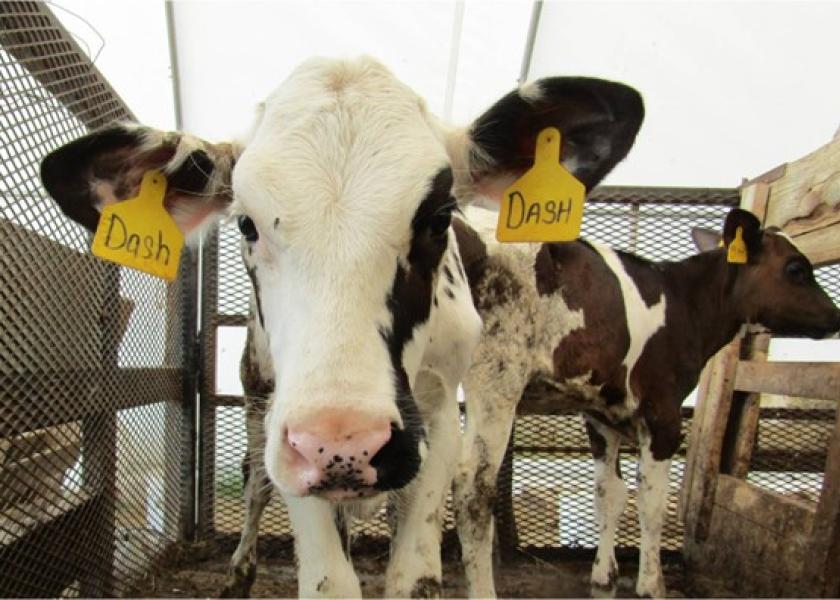MyAnIML Expands Predictive Health Platform Using Muzzles To Detect Disease

To better enable early disease prediction in cattle, agtech startup MyAnIML™ announced today a hardware update designed to support the implementation of its AI-enabled predictive health platform in commercial feedlot and dairy operations.
MyAnIML’s newly released Bluetooth-enabled cattle ear tag integrates geolocation and tracking capabilities with its powerful predictive health modeling technology to help producers manage the productivity and welfare of their herds cost-effectively.
MyAnIML’s patent-pending technology employs artificial intelligence and machine learning to predict a broad range of total health indicators using the industry’s first cattle facial - specifically muzzle - recognition library dataset, designed and built by MyAnIML. Together, the hardware and software stack offers the global beef and dairy industries a more precise method of herd health management when profit margins continue to be razor thin and the cost of meat, dairy and other food products remain high.
Based on a comprehensive analysis of cattle lost to diseases, cost of medical treatment and low productivity impacts, MyAnIML estimates the U.S. cattle industry loses approximately $200 billion annually. For example, just one disease, Bovine Respiratory (BRD), costs the U.S. feedlot industry up to $900 million annually in treatment costs although recent reports indicate that total industry losses from BRD are actually much higher when productivity losses are factored in, according to the American Society of Animal Science.
The MyAnIML platform successfully predicts cattle infected with BRD two to three days before visual symptoms are observed, allowing producers to isolate the animal and start earlier treatment. BRD is just one of many diseases and health metrics MyAnIML identifies days before other health technologies, using subtle changes in a cow’s muzzle as a health indicator.
“We know from advances in human biometrics and deep-learning technology that the face can be a reliable predictor of disease. Using the same concept, we can now “fingerprint” an individual cow’s muzzle to monitor its health and predict a variety of issues days in advance,” said Shekhar Gupta, MyAnIML’s founder and CEO, who discovered and commercialized the first-of-its-kind technology solution in animal agriculture. “By addressing symptoms early, we can better ensure the health and well-being of the entire herd for a more reliable and efficient food supply chain.”
Predictive Analytics Reduces Antibiotics Use and Creates More Resilient Supply Chains
In addition to preventing economically significant disease outbreaks, MyAnIML helps cattle producers use antibiotics more efficiently, reducing costs and inhibiting the development of antibiotic-resistant bacteria, a rising concern amongst human health professionals.
More than 70% of all medically important antibiotics sold in the U.S. are used in livestock production. The cattle industry takes up the bulk of that demand, using antibiotics to treat sick animals and as a preventative measure. A typical 5000-head feedlot spends $250,000 annually on antibiotics just to preemptively treat calves for BRD, Gupta said.
“Antibiotics have been a powerful tool to keep U.S. herds healthy, but by identifying infected animals days earlier in the disease cycle, producers can use antibiotics more efficiently when they need to support a sick animal and reduce the need for preemptive antibiotics. It’s a win-win for producers and consumer health,” Gupta said.
AI and Bluetooth Ear Tags for Animal Agriculture Offer Immediate Benefits for Ranchers
MyAnIML’s bluetooth ear tag was developed specifically to help large-scale commercial feedlots and stockyards implement the MyAnIML predictive health technology into their day-to-day operations.
Unlike other ear tag technology in the marketplace, including RFID tags, the MyAnIML tag helps pen riders quickly find a specific animal in a pen simply by using their mobile device, saving hours of labor time and more rapidly removing sick animals from the herd.
“In a large-scale, or even small-scale system, being able to accurately predict a sick cow is a huge benefit. But the follow-up of finding that animal can be a huge problem,” said Nathan Leiker, a northwestern Kansas cow-calf and feedlot operator using the MyAnIML technology since early 2022. “MyAnIML’s Bluetooth ear tags connect the dots between disease prediction and animal identification. All I have to do is push a button on my phone and it takes me directly to the cow I want. It’s the equivalent of finding a needle in a haystack with a magnet. “
How it works:
- Cameras strategically mounted take multiple images of a cow’s muzzle daily, monitoring for changes.
- These images are analyzed using AI and machine learning against a library of health indicators.
- The rancher is emailed a health alert report, with ID specific to each animal flagged with a muzzle change.
- Producers open the app to find a predicted sick animal's location and once within 20 meters, use the app's directional arrow and buzzing noise to lead them directly to the target animal.
Commercially available in the U.S. since 2022 with multiple large installations and pilot projects underway in 2023, MyAnIML has attracted interest internationally and plans rapid scale-up in the coming years. Ranchers or dairy producers interested in implementing the technology can visit myaniml.com for more information.
About MyAniML
MyAnIML, an AI startup for animal agriculture, invented and commercialized the first-of-its-kind platform for early disease prediction in cattle using facial recognition technology focused on a cow’s muzzle. The initial discovery is the product of intense curiosity and a sense of purpose by the founder, a computer scientist, and his wife, a physician. Founded in 2021, MyAnIML’s mission is to help ensure the health and well-being of cattle while ensuring an affordable and safe food supply. Partnering with veterinarians, land grant universities and ranchers, the company’s experience developing and scaling data platforms for other industries is now being applied to animal agriculture. For more information www.myaniml.com.







